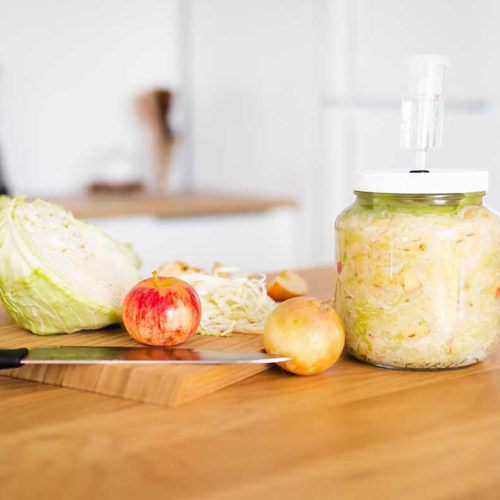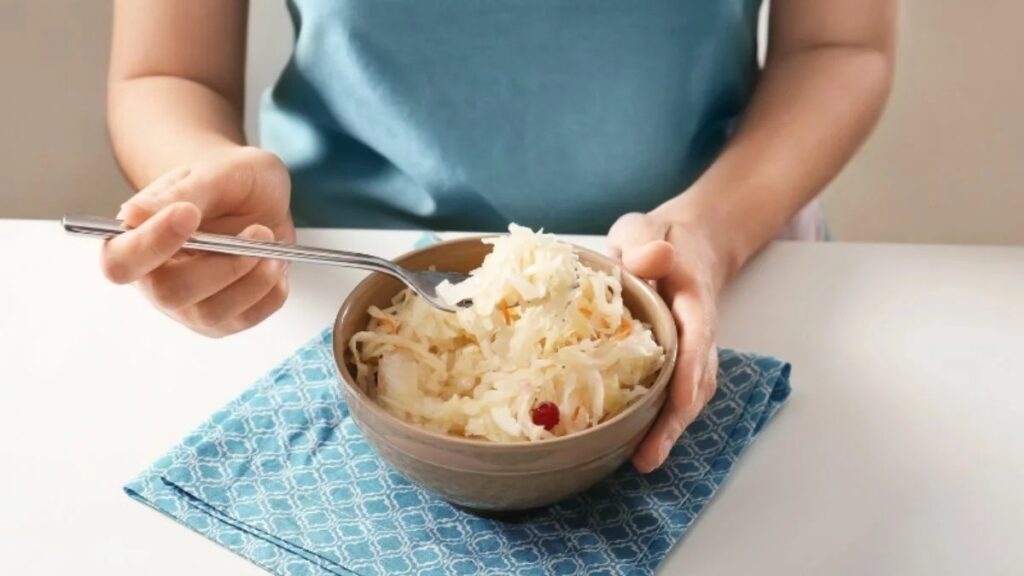Give your everyday life a boost with this onion and apple sauerkraut recipe!
Not only is this sauerkraut tasty, but it’s made with ingredients you probably already have in your pantry.
Fermented Cabbage, a Winning Recipe!
The apprentice fermenter’s baptism is often done with sauerkraut. And not for nothing! It’s almost impossible to fail and quite frankly, it’s delicious. What’s more, it features cabbage, inexpensive food that is easy to find and available year-round.
Raw cabbage is a bit bland and hard to digest. However, cabbage undergoes a complete metamorphosis during fermentation!
With salt and a little patience, cabbage turns into sauerkraut and becomes much easier to digest. One of the many benefits of lacto-fermentation.
Fermentation also develops the flavours of the cabbage, which acquires more acidity. Beware, fermented cabbage can become quite addictive!
Once you’ve mastered the famous traditional sauerkraut, why not experiment with other ingredients? In this recipe, apples and onions are added to enhance flavours.
Lacto-fermented fruit such as apples add lots of flavour and aroma to vegetable mixes, whereas onions add depth to the sauerkraut. A winning combination!
For more ideas on fermenting cabbage, check out our 6 fermented cabbage recipes from around the world.

Apple and Onion Sauerkraut Recipe
Equipment
- Scale
- Mixing bowl
Ingredients
- 1 small cabbage (850g)
- 1 large apple
- 1 small onion
- 1 teaspoon fennel seed (5ml)
- 1 tablespoon salt (or 2% of the weight of the vegetables)
Steps
- Cut the cabbage, onion, and apple (with peel) into thin slices with a knife or mandolin. Set aside one whole cabbage leaf.
- Place the bowl on the scale and set the scale to zero.
- Add all the vegetables to the bowl.
- Weigh the vegetables and multiply the weight by 2%. This will give you the amount of salt (in grams) to add.
- Sprinkle this amount of salt over the vegetables. Massage the mixture with your hands for 2 minutes to dissolve the salt and mix the ingredients.
- Let it drain for 15 minutes. The vegetables will give up most of their water.
- Transfer to the glass jar in small batches, compressing the cabbage by hand or with a packer. The liquid produced should submerge the cabbage.
- Place the whole cabbage leaf on top of the vegetables to prevent small pieces from rising to the surface. Add the ViscoDisc insert over the cabbage leaf.
- Let it stand at room temperature for 3 weeks.
- Remove the insert and discard any cabbage pieces that float to the surface.
- Enjoy!
Notes
Are you new to fermentation? Take a look at our complete guide to lacto-fermentation.
Sauerkraut can be stored in the fridge for about 1 year.
This apple and onion sauerkraut goes well with braised and roasted meats and enhances mashed potatoes.
It will add a lot of flavour to root vegetable soups (carrot, beet, parsnip, etc.). It will also liven up any boring sandwich or burger!

